Hieu H. Pham
NeurFlow: Interpreting Neural Networks through Neuron Groups and Functional Interactions
Feb 22, 2025Abstract:Understanding the inner workings of neural networks is essential for enhancing model performance and interpretability. Current research predominantly focuses on examining the connection between individual neurons and the model's final predictions. Which suffers from challenges in interpreting the internal workings of the model, particularly when neurons encode multiple unrelated features. In this paper, we propose a novel framework that transitions the focus from analyzing individual neurons to investigating groups of neurons, shifting the emphasis from neuron-output relationships to functional interaction between neurons. Our automated framework, NeurFlow, first identifies core neurons and clusters them into groups based on shared functional relationships, enabling a more coherent and interpretable view of the network's internal processes. This approach facilitates the construction of a hierarchical circuit representing neuron interactions across layers, thus improving interpretability while reducing computational costs. Our extensive empirical studies validate the fidelity of our proposed NeurFlow. Additionally, we showcase its utility in practical applications such as image debugging and automatic concept labeling, thereby highlighting its potential to advance the field of neural network explainability.
FedBlock: A Blockchain Approach to Federated Learning against Backdoor Attacks
Nov 05, 2024



Abstract:Federated Learning (FL) is a machine learning method for training with private data locally stored in distributed machines without gathering them into one place for central learning. Despite its promises, FL is prone to critical security risks. First, because FL depends on a central server to aggregate local training models, this is a single point of failure. The server might function maliciously. Second, due to its distributed nature, FL might encounter backdoor attacks by participating clients. They can poison the local model before submitting to the server. Either type of attack, on the server or the client side, would severely degrade learning accuracy. We propose FedBlock, a novel blockchain-based FL framework that addresses both of these security risks. FedBlock is uniquely desirable in that it involves only smart contract programming, thus deployable atop any blockchain network. Our framework is substantiated with a comprehensive evaluation study using real-world datasets. Its robustness against backdoor attacks is competitive with the literature of FL backdoor defense. The latter, however, does not address the server risk as we do.
MSTAR: Multi-Scale Backbone Architecture Search for Timeseries Classification
Feb 21, 2024



Abstract:Most of the previous approaches to Time Series Classification (TSC) highlight the significance of receptive fields and frequencies while overlooking the time resolution. Hence, unavoidably suffered from scalability issues as they integrated an extensive range of receptive fields into classification models. Other methods, while having a better adaptation for large datasets, require manual design and yet not being able to reach the optimal architecture due to the uniqueness of each dataset. We overcome these challenges by proposing a novel multi-scale search space and a framework for Neural architecture search (NAS), which addresses both the problem of frequency and time resolution, discovering the suitable scale for a specific dataset. We further show that our model can serve as a backbone to employ a powerful Transformer module with both untrained and pre-trained weights. Our search space reaches the state-of-the-art performance on four datasets on four different domains while introducing more than ten highly fine-tuned models for each data.
Learning to Estimate Critical Gait Parameters from Single-View RGB Videos with Transformer-Based Attention Network
Dec 01, 2023


Abstract:Musculoskeletal diseases and cognitive impairments in patients lead to difficulties in movement as well as negative effects on their psychological health. Clinical gait analysis, a vital tool for early diagnosis and treatment, traditionally relies on expensive optical motion capture systems. Recent advances in computer vision and deep learning have opened the door to more accessible and cost-effective alternatives. This paper introduces a novel spatio-temporal Transformer network to estimate critical gait parameters from RGB videos captured by a single-view camera. Empirical evaluations on a public dataset of cerebral palsy patients indicate that the proposed framework surpasses current state-of-the-art approaches and show significant improvements in predicting general gait parameters (including Walking Speed, Gait Deviation Index - GDI, and Knee Flexion Angle at Maximum Extension), while utilizing fewer parameters and alleviating the need for manual feature extraction.
MPCNN: A Novel Matrix Profile Approach for CNN-based Sleep Apnea Classification
Nov 25, 2023Abstract:Sleep apnea (SA) is a significant respiratory condition that poses a major global health challenge. Previous studies have investigated several machine and deep learning models for electrocardiogram (ECG)-based SA diagnoses. Despite these advancements, conventional feature extractions derived from ECG signals, such as R-peaks and RR intervals, may fail to capture crucial information encompassed within the complete PQRST segments. In this study, we propose an innovative approach to address this diagnostic gap by delving deeper into the comprehensive segments of the ECG signal. The proposed methodology draws inspiration from Matrix Profile algorithms, which generate an Euclidean distance profile from fixed-length signal subsequences. From this, we derived the Min Distance Profile (MinDP), Max Distance Profile (MaxDP), and Mean Distance Profile (MeanDP) based on the minimum, maximum, and mean of the profile distances, respectively. To validate the effectiveness of our approach, we use the modified LeNet-5 architecture as the primary CNN model, along with two existing lightweight models, BAFNet and SE-MSCNN, for ECG classification tasks. Our extensive experimental results on the PhysioNet Apnea-ECG dataset revealed that with the new feature extraction method, we achieved a per-segment accuracy up to 92.11 \% and a per-recording accuracy of 100\%. Moreover, it yielded the highest correlation compared to state-of-the-art methods, with a correlation coefficient of 0.989. By introducing a new feature extraction method based on distance relationships, we enhanced the performance of certain lightweight models, showing potential for home sleep apnea test (HSAT) and SA detection in IoT devices. The source code for this work is made publicly available in GitHub: https://github.com/vinuni-vishc/MPCNN-Sleep-Apnea.
TransReg: Cross-transformer as auto-registration module for multi-view mammogram mass detection
Nov 09, 2023

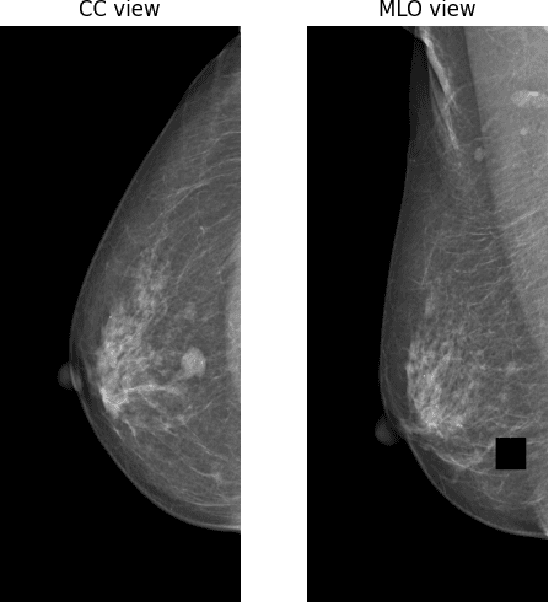

Abstract:Screening mammography is the most widely used method for early breast cancer detection, significantly reducing mortality rates. The integration of information from multi-view mammograms enhances radiologists' confidence and diminishes false-positive rates since they can examine on dual-view of the same breast to cross-reference the existence and location of the lesion. Inspired by this, we present TransReg, a Computer-Aided Detection (CAD) system designed to exploit the relationship between craniocaudal (CC), and mediolateral oblique (MLO) views. The system includes cross-transformer to model the relationship between the region of interest (RoIs) extracted by siamese Faster RCNN network for mass detection problems. Our work is the first time cross-transformer has been integrated into an object detection framework to model the relation between ipsilateral views. Our experimental evaluation on DDSM and VinDr-Mammo datasets shows that our TransReg, equipped with SwinT as a feature extractor achieves state-of-the-art performance. Specifically, at the false positive rate per image at 0.5, TransReg using SwinT gets a recall at 83.3% for DDSM dataset and 79.7% for VinDr-Mammo dataset. Furthermore, we conduct a comprehensive analysis to demonstrate that cross-transformer can function as an auto-registration module, aligning the masses in dual-view and utilizing this information to inform final predictions. It is a replication diagnostic workflow of expert radiologists
Learning Robust and Consistent Time Series Representations: A Dilated Inception-Based Approach
Jun 11, 2023Abstract:Representation learning for time series has been an important research area for decades. Since the emergence of the foundation models, this topic has attracted a lot of attention in contrastive self-supervised learning, to solve a wide range of downstream tasks. However, there have been several challenges for contrastive time series processing. First, there is no work considering noise, which is one of the critical factors affecting the efficacy of time series tasks. Second, there is a lack of efficient yet lightweight encoder architectures that can learn informative representations robust to various downstream tasks. To fill in these gaps, we initiate a novel sampling strategy that promotes consistent representation learning with the presence of noise in natural time series. In addition, we propose an encoder architecture that utilizes dilated convolution within the Inception block to create a scalable and robust network architecture with a wide receptive field. Experiments demonstrate that our method consistently outperforms state-of-the-art methods in forecasting, classification, and abnormality detection tasks, e.g. ranks first over two-thirds of the classification UCR datasets, with only $40\%$ of the parameters compared to the second-best approach. Our source code for CoInception framework is accessible at https://github.com/anhduy0911/CoInception.
Evaluating the impact of an explainable machine learning system on the interobserver agreement in chest radiograph interpretation
Apr 01, 2023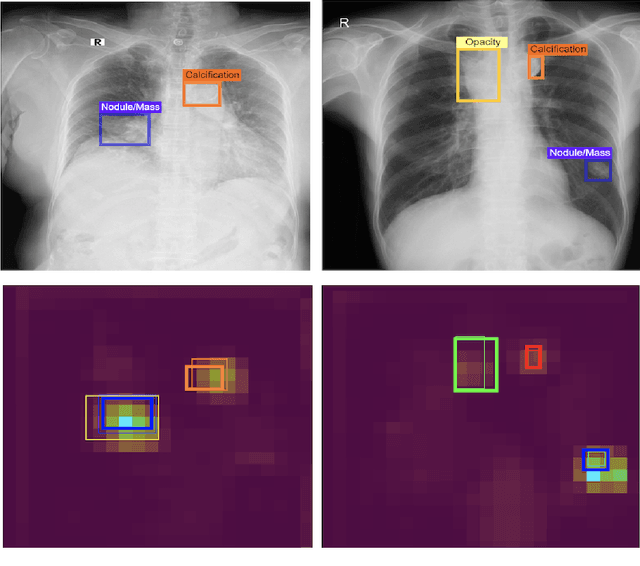

Abstract:We conducted a prospective study to measure the clinical impact of an explainable machine learning system on interobserver agreement in chest radiograph interpretation. The AI system, which we call as it VinDr-CXR when used as a diagnosis-supporting tool, significantly improved the agreement between six radiologists with an increase of 1.5% in mean Fleiss' Kappa. In addition, we also observed that, after the radiologists consulted AI's suggestions, the agreement between each radiologist and the system was remarkably increased by 3.3% in mean Cohen's Kappa. This work has been accepted for publication in IEEE Access and this paper is our short version submitted to the Midwest Machine Learning Symposium (MMLS 2023), Chicago, IL, USA.
Improving Object Detection in Medical Image Analysis through Multiple Expert Annotators: An Empirical Investigation
Mar 29, 2023
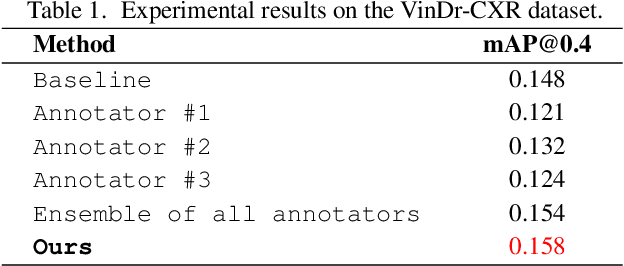
Abstract:The work discusses the use of machine learning algorithms for anomaly detection in medical image analysis and how the performance of these algorithms depends on the number of annotators and the quality of labels. To address the issue of subjectivity in labeling with a single annotator, we introduce a simple and effective approach that aggregates annotations from multiple annotators with varying levels of expertise. We then aim to improve the efficiency of predictive models in abnormal detection tasks by estimating hidden labels from multiple annotations and using a re-weighted loss function to improve detection performance. Our method is evaluated on a real-world medical imaging dataset and outperforms relevant baselines that do not consider disagreements among annotators.
Backdoor Attacks and Defenses in Federated Learning: Survey, Challenges and Future Research Directions
Mar 03, 2023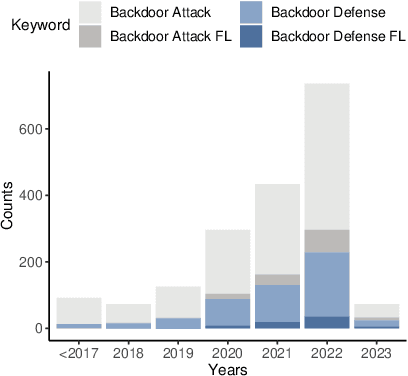
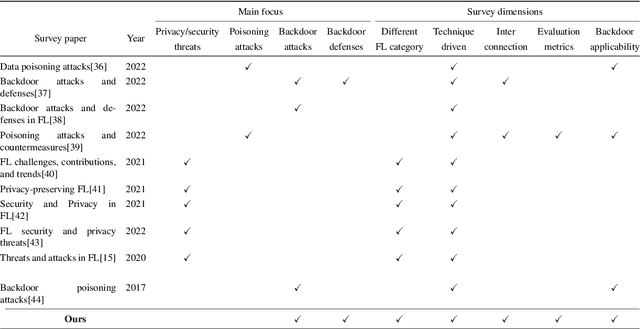
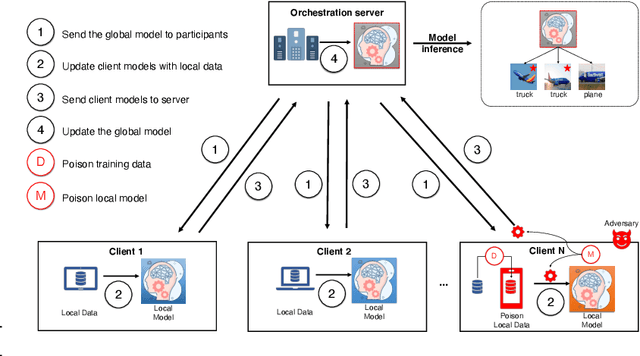
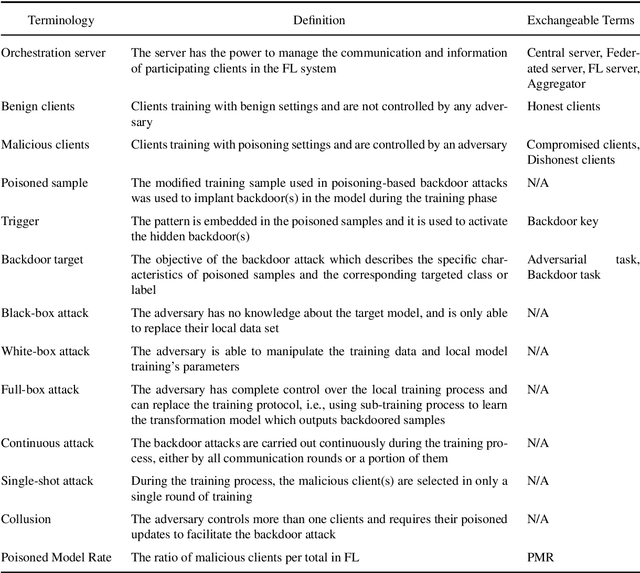
Abstract:Federated learning (FL) is a machine learning (ML) approach that allows the use of distributed data without compromising personal privacy. However, the heterogeneous distribution of data among clients in FL can make it difficult for the orchestration server to validate the integrity of local model updates, making FL vulnerable to various threats, including backdoor attacks. Backdoor attacks involve the insertion of malicious functionality into a targeted model through poisoned updates from malicious clients. These attacks can cause the global model to misbehave on specific inputs while appearing normal in other cases. Backdoor attacks have received significant attention in the literature due to their potential to impact real-world deep learning applications. However, they have not been thoroughly studied in the context of FL. In this survey, we provide a comprehensive survey of current backdoor attack strategies and defenses in FL, including a comprehensive analysis of different approaches. We also discuss the challenges and potential future directions for attacks and defenses in the context of FL.
 Add to Chrome
Add to Chrome Add to Firefox
Add to Firefox Add to Edge
Add to Edge